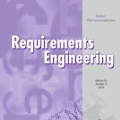The automatic extraction of structure from text can be difficult for machines. Yet, the elicitation of this information can provide many benefits and opportunities for various applications. Benefits have also been identified for the area of Requirements Engineering. To evaluate what work has been done and is currently available, the paper at hand provides an integrative review regarding Natural Language Processing (NLP) tools for Requirements Engineering. This assessment was conducted to provide a foundation for future work as well as deduce insights from the stats quo. To conduct the review, the history of Requirements Engineering and NLP are described as well as an evaluation of over 136 NLP tools. To assess these tools, a set of criteria was defined. The results are that currently no open source approach exists that allows for the direct/primary extraction of information structure and even closed source solutions show limitations such as supervision or input limitations, which eliminates the possibility for fully automatic and universal application. As a results, the authors deduce that the current approaches are not applicable and a different methodology is necessary. An approach that allows for individual management of the algorithm, knowledge base, and text corpus is a possibility being pursued.
翻译:自动从文字中抽取结构对机器来说可能很困难。然而,这种信息的收集可以为各种应用提供许多好处和机会。还确定了要求工程领域的效益。为了评估已经做了哪些工作而且目前已有哪些工作,手头的文件对要求工程的自然语言处理工具进行了综合审查。这项评估是为了为今后的工作提供基础并从现状中推导出见解。为了进行审查,描述了要求工程和要求工程的历史,并对超过136种要求工程工具进行了评估。为了评估这些工具,确定了一套标准。结果显示,目前不存在允许直接/主要提取信息结构的开放源法,甚至封闭源解决方案都显示出限制,例如监督或投入限制,从而消除了完全自动和普遍应用的可能性。结果是,作者推断,目前的方法并不适用,需要采用不同的方法。一种允许个人管理算法、知识基础和文字材料的方法是可能的。














